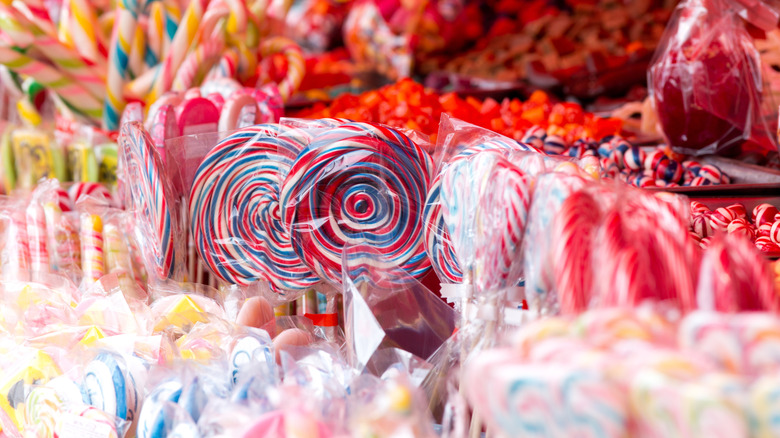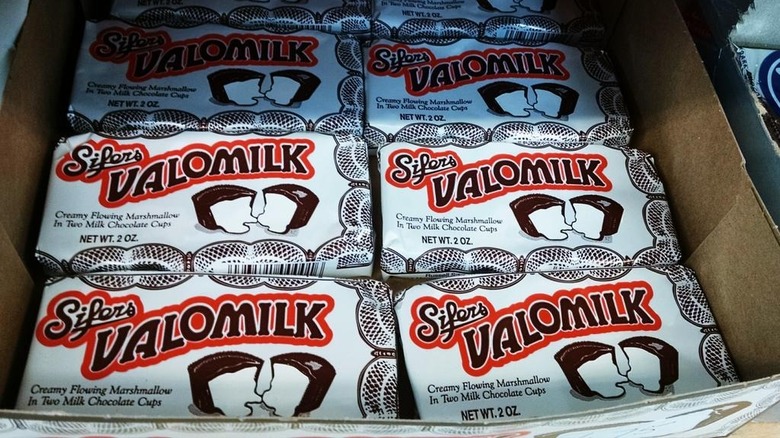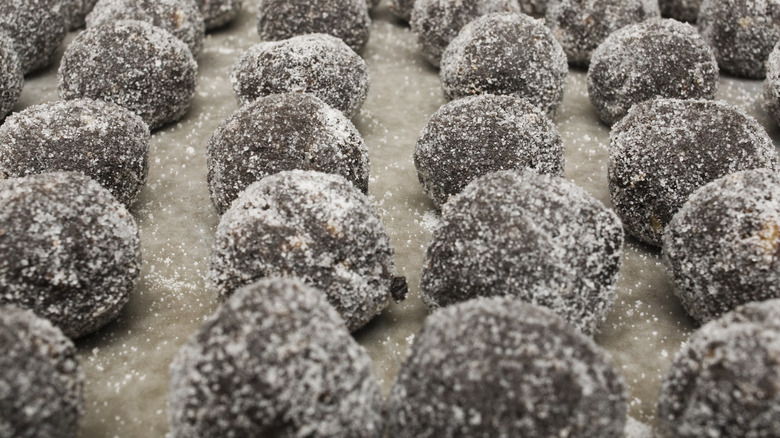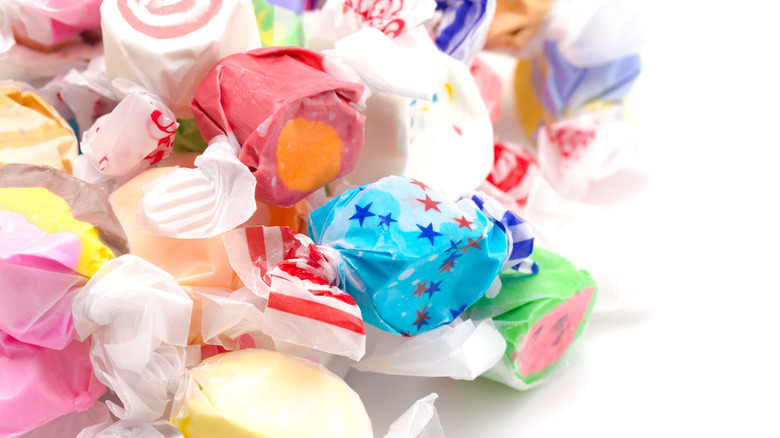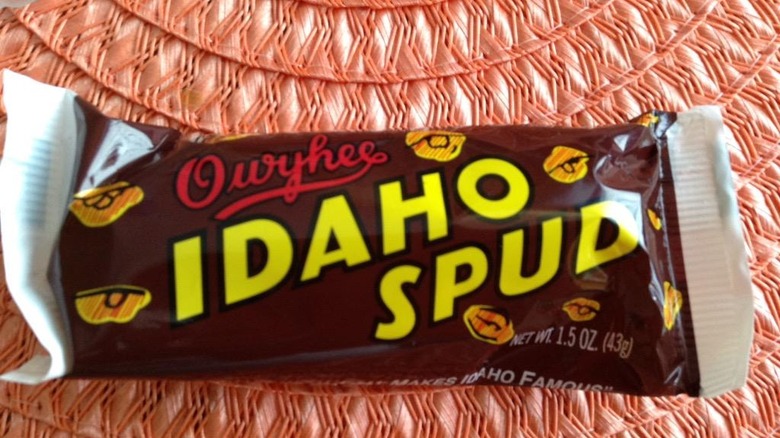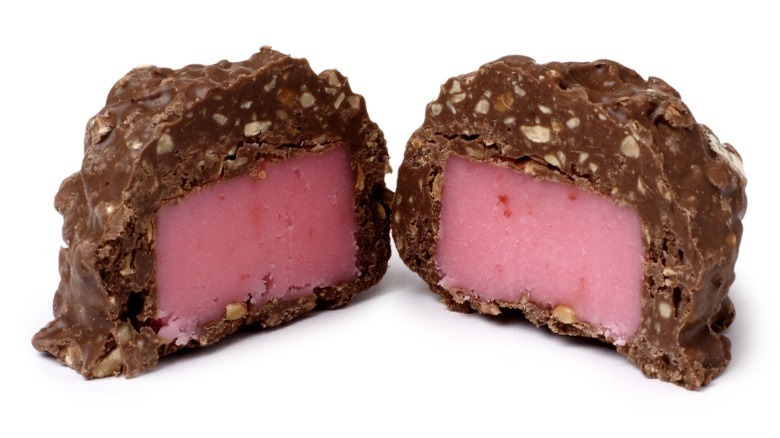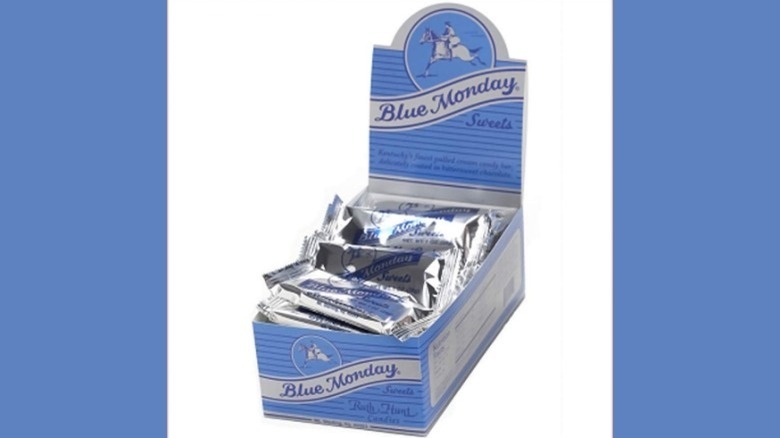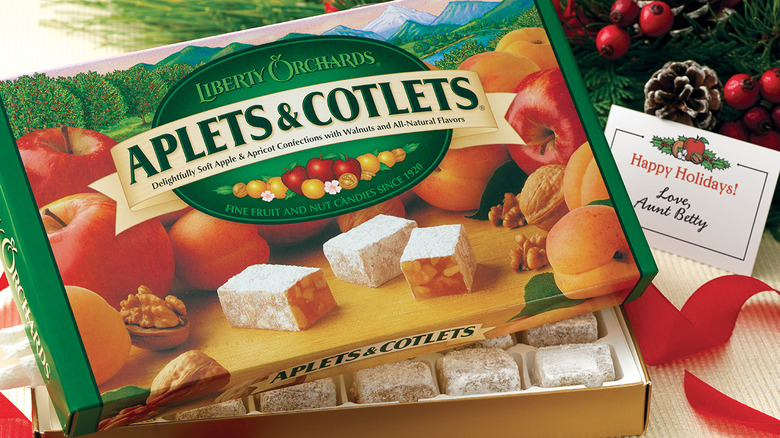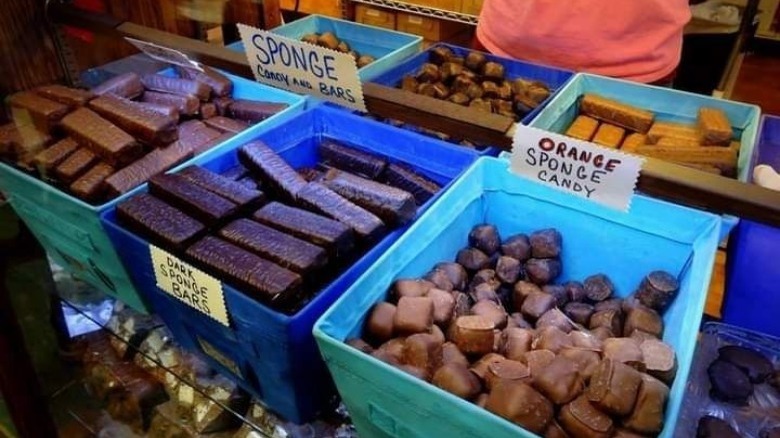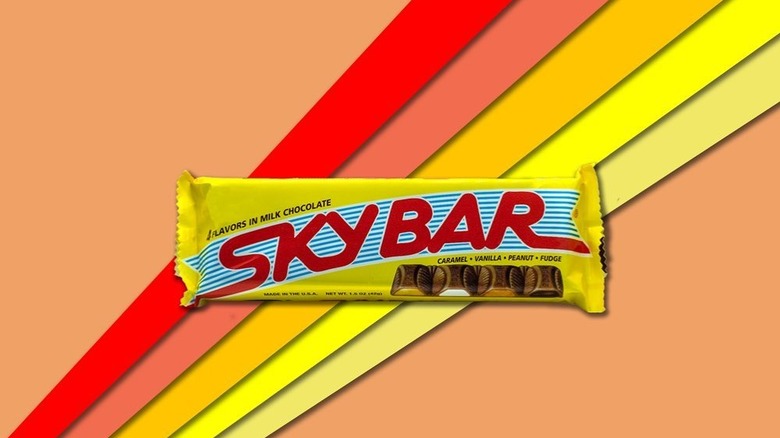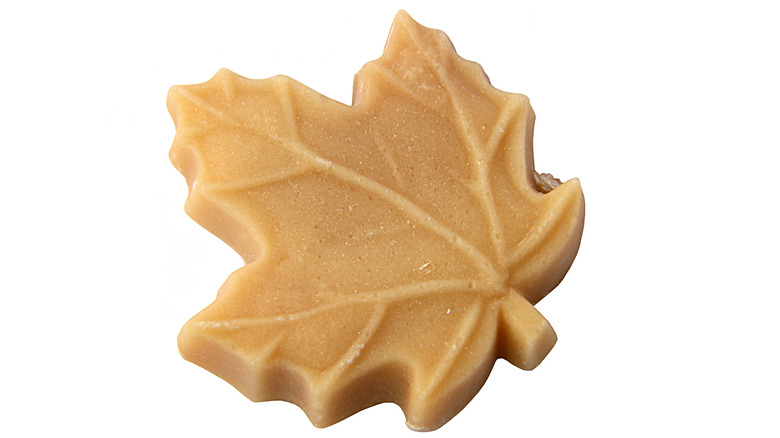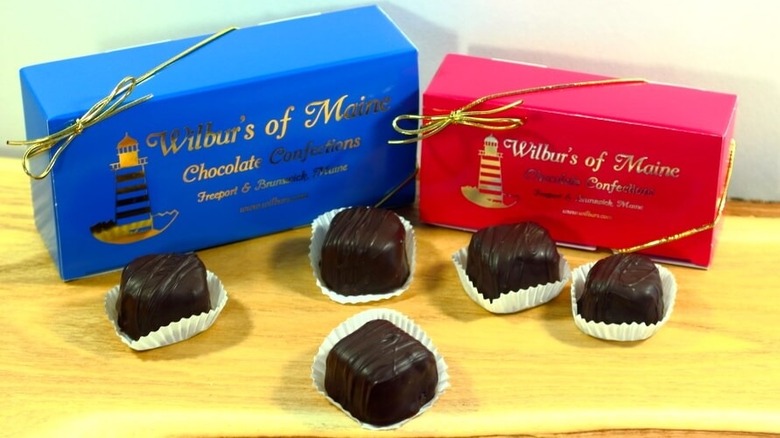11 Regional Candies You Need To Try
Is there anyone on this wonderful, fragile, pale blue dot, that doesn't enjoy the taste of candy? Well, besides dentists, killjoys, and people that don't have a sweet tooth inside their entire bod. Because candy can be absolutely scrumptious. It can feature chocolate, it can feature peanuts nut, and it can feature marshmallows. Suffice to say, candy can contain the best of ingredients. These little treats can be the perfect snack on vacation, an afternoon, or when you want to procrastinate doing actual work at the office.
Moreover, there are a ton of delicious candies out there that you might've never taste-tested. And no, they're not made by the Mars company, they're not a stack of the 500,000 M&M's flavors that are out there. Across the countryside and in the cityscapes of America, there are some unique and special regional candies that one can nom upon.
But what are the regional American candies worth trying? And where did they come from? And what makes them so spesh? Well, if those questions have been bouncing around you're noggin, don't fret. Because we're about list some of the best regional candies worth trying.
1. Valomilk
Imagine this: a candy with a runny marshmallow interior and a hard chocolate exterior. Now, if this hypothetical candy is your dream snack, then you need to head to Kansas to try a Valomilk. Because this treat is exactly that. On Valomilk's website, they state their candy's melty marshmallow insides are made out of cane sugar, corn syrup, egg whites, bourbon vanilla, water, and salt. They also state that their chocolate is made from a 1931 recipe that features cocoa beans, cocoa butter, and actual vanilla.
It's also worth noting that these delicious treats were first created by true chance. According to Valomilk's history page, this candy came about because one of their candy makers named Tommy was inebriated, from drinking too much of the factory's alcoholic vanilla, and he wrecked a batch of marshmallows. Tommy hadn't set them up to cool off, so they became runny instead. However, another candymaker named Harry Sifers put the melted marshmallows into cups made out of chocolate, and thus the first type of Valomilk had come to be.
If this type of candy seems like it'd be your vibe, then you better find a way to support the people that make them. In 2020, KCUR-FM reported that the Valomilk Candies company was struggling because of the COVID-19 pandemic. This fact demonstrates how fragile independent, regional candies can become in our current economic landscape.
2. Bourbon Balls
According to All Recipes, bourbon balls are a Kentucky candy that one can actually make in their very own home. All you need to do is soak some nuts in Kentucky bourbon overnight, mix them with some butter and sugar, refrigerate your mixture for another night, roll this goodness into a whack of balls, and then cover them in some melted chocolate. Yup, making bourbon balls is really that easy.
But who invented such a delicious boozy candy? Well, in an article by VinePair, they stated that these treats were invented by Hanly Booe in Kentucky sometime around 1938. Two years prior, Booe was the owner of the Rebecca Ruth candy store and was struggling to keep the business afloat. However, everything changed when she talked to a visiting dignitary, Eleanor Hume Offutt, who said stated that she loved chocolate and Kentucky bourbon. Well, it was Offutt or the Kentucky Governor Ruby Laffoon who expressed this notion, this detail of the story has a contested history.
Nevertheless, whether it was Hume or Laffoon that plugged chocolate and Kentucky bourbon, Booe was inspired to combine them into a delicious candy. It then took her two years or less to refine her bourbon balls recipe, and these treats sold superbly well. It's a testament to Booe's skills as a candymaker that Kentucky bourbon balls are still enjoyed over 80 years later.
3. Saltwater taffy
As Insider stated in 2021, there's actually no salt in saltwater taffy. In a video which they produced, journalist Medha Imam says that they typically contain "molasses or sugar, water, and butter." These ingredients are then mixed, made into stretchy ropes, put into taffy-cooking machines, cooked at 250 degrees, slowly cooled, and then mechanically rolled down to size before getting cut up. Yup, these pieces of candy are more complex than they appear to be!
Imam also states that salt water taffy is a star of the Jersey Shore area. She then goes on to add, "Jersey Shore may have a bad rep, but its most redeeming quality is quite possibly its saltwater taffy. It's an old-school carnival snack that became popular in the late 1800s."
Now, if you're curious as to why this saltless taffy was titled saltwater taffy, then Imam outlines its origin story. In Insider's vid, she explains, "There was a man named Mr. Bradley who sold taffy from a stand on a beach. One evening, the water came up and washed over his taffy. He thought his taffy was ruined, but a little girl approached him and asked if she could have a piece of his saltwater taffy. And since then, the name stuck."
4. Idaho Spud
Just like the Jersey Shore's saltless saltwater taffy, the Idaho Spud doesn't contain any potato whatsoever. (Seriously, what's with some of these regional candies cheekily misleading names?) However, Idaho Spuds are made in Idaho, and while the candies don't have any taters in them, they seem super-duper topnotch. These champs have a dark chocolate shell, that's been sprinkled with coconut, and are marshmallowed on the inside.
But why are Idaho Spuds called Idaho Spuds if they don't feature any spuds? Well, it's because there molded to look like potatoes. Additionally, a lot of Northwestern folks seem to like these taterless treats, as they are one of the best-selling candies in the region. To further emphasize the popularity of these chocolate spuds, their manufacturers, called the Idaho Candy Company, have asserted that these chocolate sweets are the brand's bestselling candy bar.
Idaho Spuds have also been around for more than a hot minute. The Idaho Candy Company stated that they were originally made in 1918. And strangely enough, they were first advertised as being a healthy candy. This is because the Idaho Spud doesn't contain gelatin and instead has agar agar in them. Does this make them healthy by modern standards? No, of course not. But are these old-fashioned candy bars an A+ time to indulge in? Only your taste buds can answer that question.
5. Cherry Mash
Ah, finally, another candy that's not just scrumptious, it also properly lives up to its own name. Cherry Mash is a treat that stars a mix of fondant cream and maraschino cherries in its center. This creamy combo is then covered with two layers of a chocolate and peanut mixture. The fondant cream, the cherries, the choc, and the peanuts all exquisitely complement each other, fusing into a consistent bit of candy that's a 12/10 for your taste buds.
The Cherry Mash was first created in 1918, in St. Joseph, Missouri. These treats then went on to survive the lows of the Great Depression, have been made for over 100 years, and, of course, are a historic Midwestern candy. And if these facts don't speak to the quality of this product, who knows what fact would. If you're a fan of candies that feature a real cherry taste, then you might want to try a single Cherry Mash or demolish a whole crate of these beauties.
6. Blue Monday Sweets
Who hasn't experienced the Monday blues? Maybe your car broke down on the way to work, or maybe it didn't and you had wished that it did. Well, whatever makes your start of the week the pits, maybe a Blue Monday Sweet could be your ticket out it. This 1930s Kentucky treat was supposedly named by the candy maker Ruth Hunt after she talked with a traveling minister. The story goes that Hunt couldn't settle on what to call this candy, and then this minister asserted that he'd "always needed a little sweet to cure his Blue Monday."
So, with all of this in mind, what exactly is in a Blue Monday Sweet? Well, according to the Ruth Hunt Candies' site, these sweets have cream candy interiors and dark chocolate exteriors. These two flavor profiles complement each other to make a well-rounded experience. So, if that description makes your brain light up, then you should maybe find yourself in Kentucky soon.
7. Aplets & Cotlets
Now, if you feel as if this regional candies list doesn't star enough fruity flavors, then here's a candy for your tasty taste buds. Introducing Washington's Aplets & Cotlets! If were you to buy a box of these snackos, the aplets are a mix of apple concentrate, walnuts, and pectin, whilst the cotlets are a mix of apricot concentrate, walnuts, and pectin. The softness of these candies contrasts with the crunchiness of their walnuts to create outstanding little sweets.
According to Liberty Orchards, Aplets & Cotlets were first invited by two farmers called Armen Tertsagian and Mark Balaban sometime during the 1930s or 1940s. These treats first came about because these folks had a surplus of apples, and they wanted to use them to create a version of Turkish delight. After spending some time perfecting their apples and walnuts recipe, their treat was released to the public and was a hit. Several years later, Tertsagian and Balaban started making an apricot version of this candy, before settling later on selling Aplets & Cotlets as bundles.
In 2008, The Seattle Times even reported that Representative Mike Armstrong wanted to introduce official legislation that would make Aplets & Cotlets Washington's official candy. However, this never came to be, as the Washington State Legislature's website stated that this proposal was shot down in both 2009 and 2010. Nevertheless, the fact that this candy was nominated for this role says a lot about its importance to the Washington area.
8. Sponge candy
As expressed by Niagara Chocolates, sponge candies are an iconic Western New York treat. These sweets are comprised of a toffee center and a chocolate exterior. The toffee centers are made out of corn syrup, sugar, and baking soda, while the chocolate typically has a creamy quality. If you've ever had cinder toffee from the U.K or fairy food candy from Wisconsin, then you've definitely had a feed that's close to a sponge candy. But that being said, Niagara Chocolates have insisted that this item has a distinctive texture and taste that sets it apart from these other snacks.
However, while New York's sponge candies are a frothed over treat in the area, Buffalo Spree expressed that the origin of this product is basically a mystery. Most people agree that popped up sometime in the 1940s, as a result of a "happy" baking accident, but that's about it. Sam Mancuso, a consultant for Merckens Chocolate stated after the sponge candy was made, this product's creation would have been shared around the candy-making community. Mancuso expressed, "There are no secrets in this industry. People are very helpful to each other."
9. Sky Bar
In 1938, the Sky Bar hit the scene after being created by the folks at the New England Confectionery Company. These candy bars were the first ones ever to feature segments that had different flavors but were encased in the same type of chocolate. According to an advertisement in the Boston Globe from that year, these bars originally contained English toffee, nougat, nut butter toffee, and fudge parfait. However, Sky Bars no longer contain these flavors and instead feature are caramel, vanilla, peanut, and fudge segments.
It's also worth noting that Boston.com discussed the fact that there was a time where these candy bars weren't produced for an entire year. This was because the New England Confectionery Company went out of business in 2018. However, Louise Mawhinney, the owner of a place called Duck Soup, purchased the rights to make Sky Bars in 2019, and these candies are still on the market today.
10. Maple sugar candy
According to Business Insider, Vermont is known for making the delicious condiment known as maple syrup. As a narrator of theirs said in one of their vids, "Dubbed the maple-syrup capital of the US, the tiny state produces 40% of the maple syrup in the entire United States. In fact, Vermont's production has grown 254% since 2000."
However, while maple syrup is extraordinary, it is unfortunately frowned upon to skull it straight from the bottle. And if this fact upsets you, then you might want to try out Vermont's maple sugar candies. The Vermont Country Store stated on its site that these treats are made by whipping crystalline maple syrup, pouring this mixture into molds, and then letting it cool down. Yup, that's right, these pieces of candy contain only a single, solitary ingredient, and that ingredient is Vermont maple syrup.
The Vermont Country Store also expressed that these treats have a unique texture and strong mapley flavor. They then go on to claim that this item is one of the most popular candies that they produce. Nevertheless, there's only one way to discover if these items live up to these descriptions, and that's to give them a good, old-fashioned taste test.
11. Needhams
Needhams are another regional candy that can be easily made by following a recipe, such as the one published by New England Today. According to their instructions, you could have a crack at making these Maine classics by first mixing salt, sugar, butter, vanilla, coconut, and potato together in a bowl. That's right, these candies feature potato in them, moving on. You then press this mixture into a pan before letting it get to room temperature. After that, you dip slices of your creation into melted chocolate before storing them in an airtight container.
In an NPR article from 2012, they expressed that the origins of these needhams are hazy at best. These treats were maybe invented by a Rev. Needham, who either took these treats to his church or was a candymaker. Either way, these New England sweets are such a unique experience that they are sure to pique your interest.
